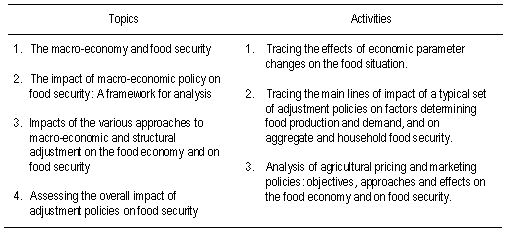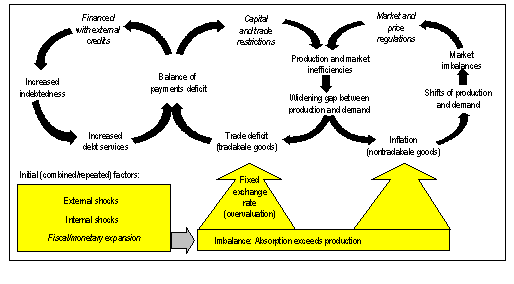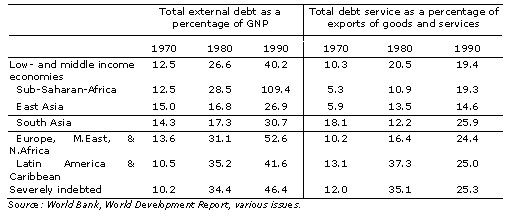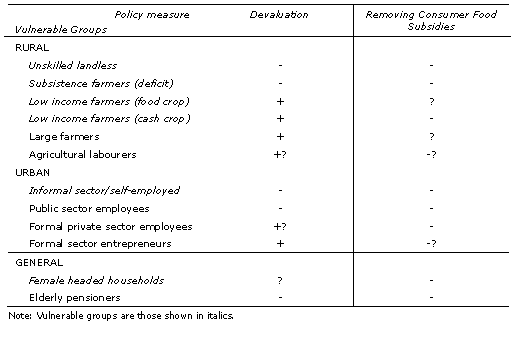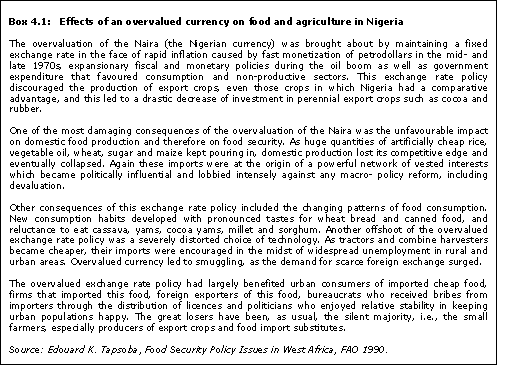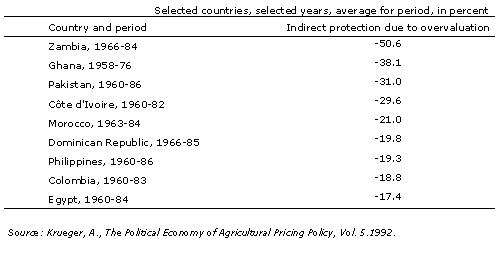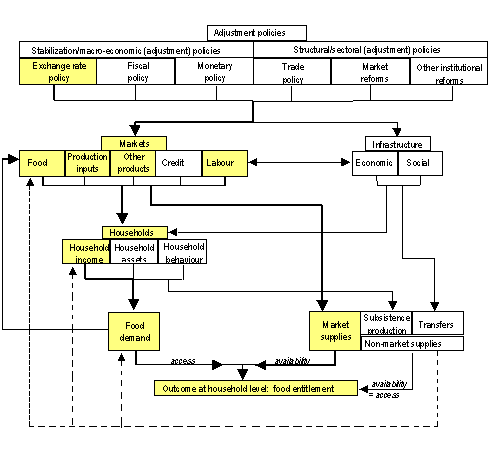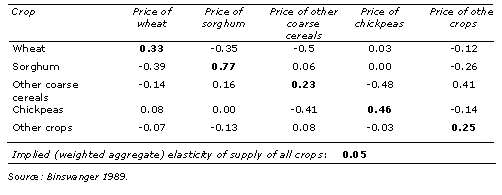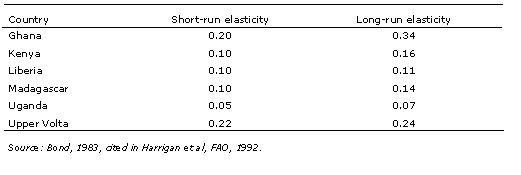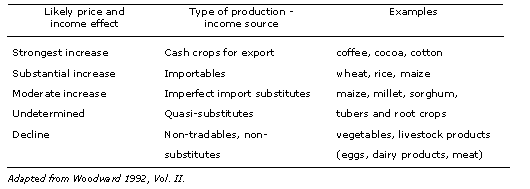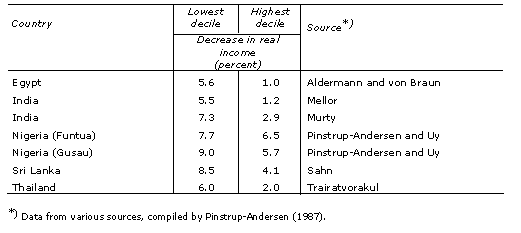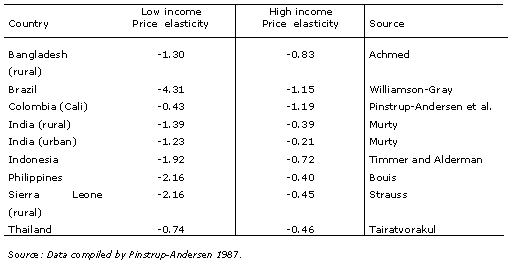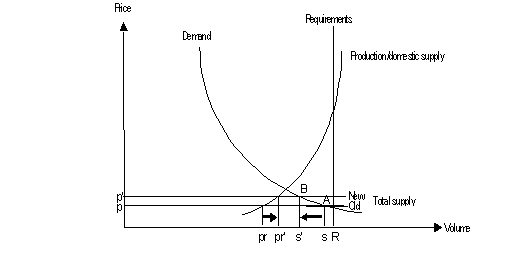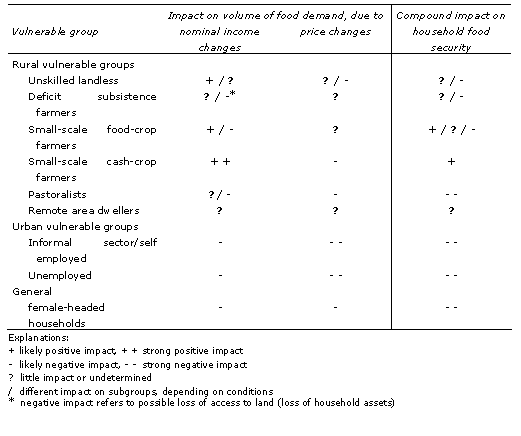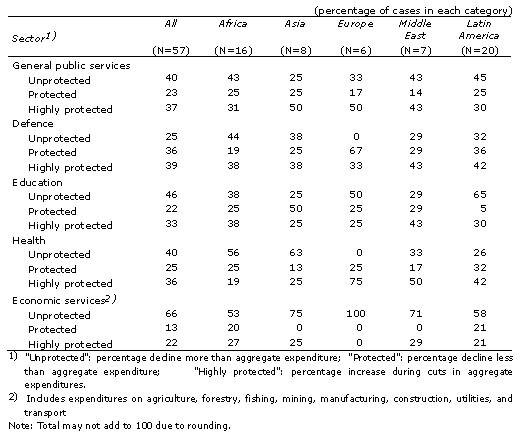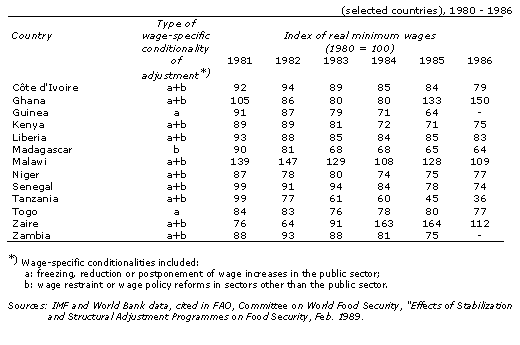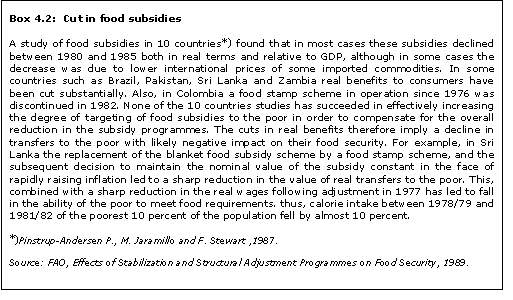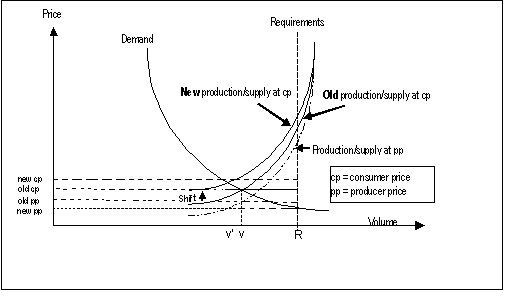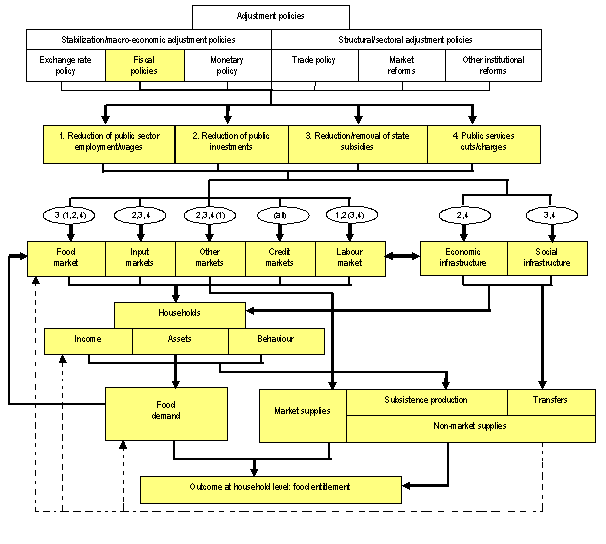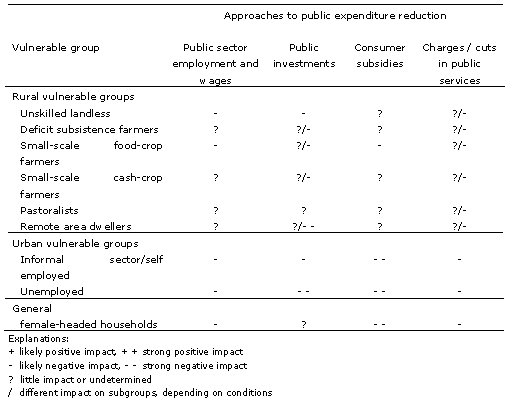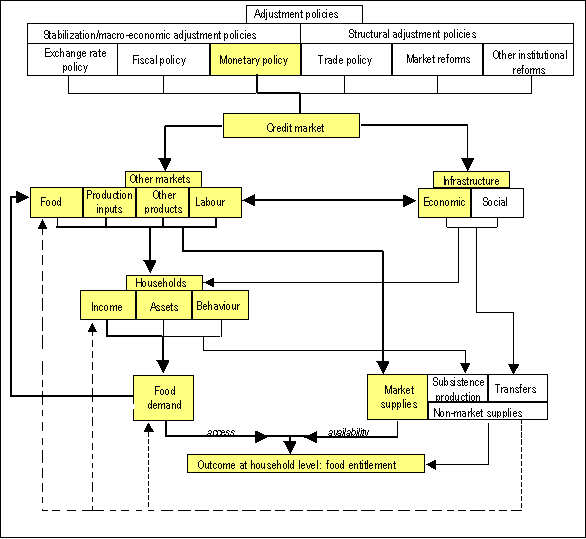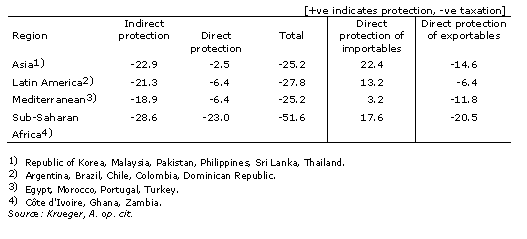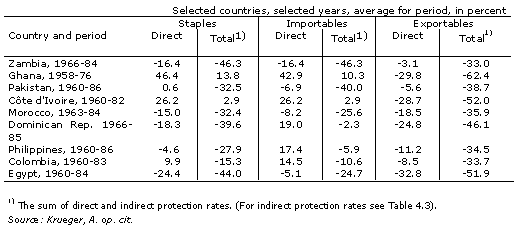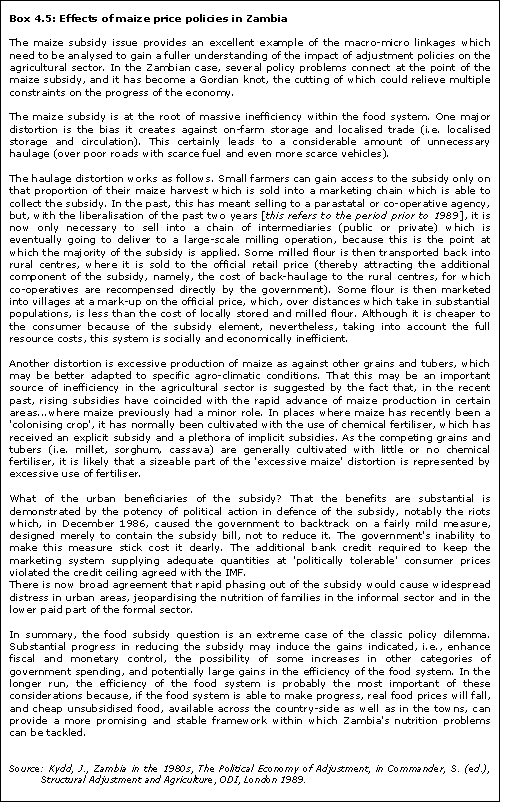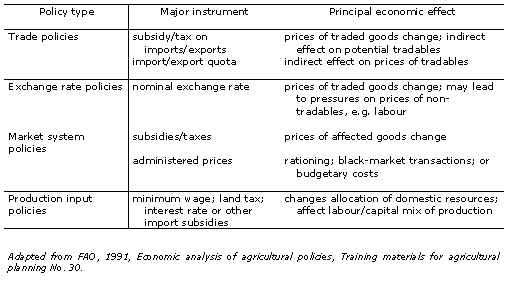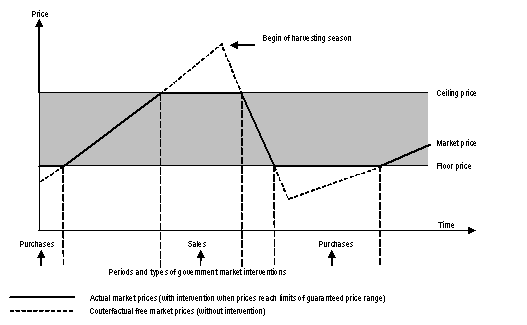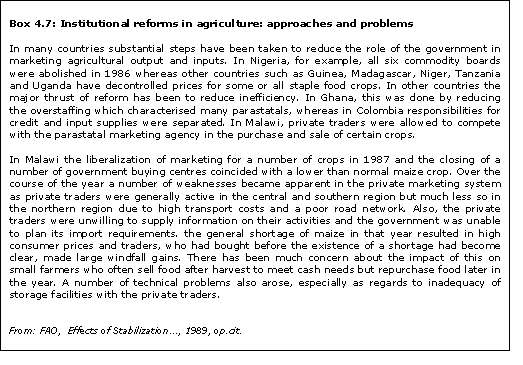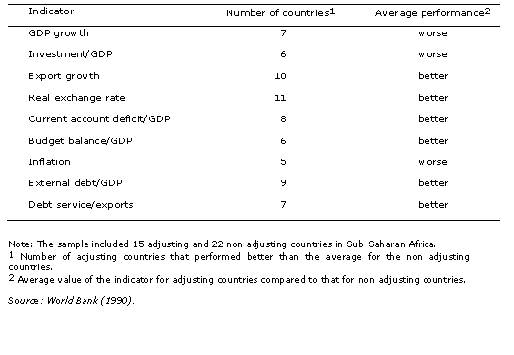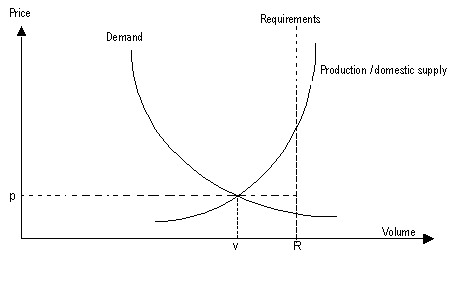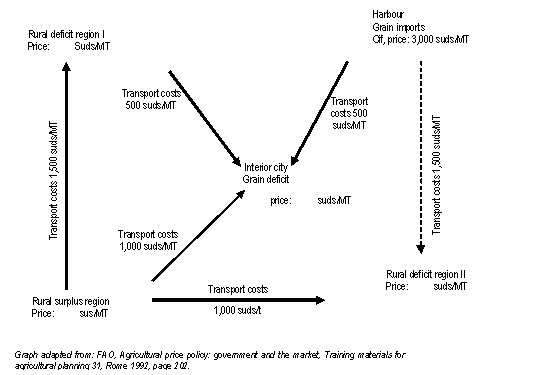|
Implications of Economic Policy for Food Security : A Training Manual |
||||
|
|
||||
|
Chapter 4 : Impact of Policy on Food Security
Objectives
By the end of this chapter, participants will:
1. have an understanding of the causes of macro-economic imbalances and of the rationale behind as well as the approaches to stabilisation and structural adjustment policies,
2. be able to trace the main lines of impact of macro-economic and structural adjustment policies on the parameters determining aggregate national and household food security,
3. be aware of the implications of adjustment policies for the food situation and food security of poor and vulnerable groups.
References
FAO, World Food Summit Papers on relevant issues (please see References).
FAO, 1989, Effects of stabilization and structural adjustment programmes on food security, FAO Economic and Social Development Paper 89, Rome.
FAO, 1992, Agricultural price policy: government and the market, Training Materials for Agricultural Planning 31, Rome.
Norton, R., 1992, Integration of food and agricultural policy with macro-economic policy: methodological consideration in a Latin American perspective, FAO Economic and Social Development Paper 111, Rome.
Woodward, D., 1992, Debt, Adjustment and Poverty in Developing Countries, Vol. I & II, Save the Children, London.
Up until this point in the manual, the emphasis has been on the food chain itself, how it links with the agricultural sector, and the relationship that individuals and households have with the food system as producers, consumers and distributors. These are essentially relationships at the micro level, whether the main element of these interactions is social, economic or political. This module introduces the macro-economic relationships which can affect very fundamentally the constraints and incentives which individuals face when trying to satisfy their food needs. The macro-economic environment is determined by certain crucial parameters and rules, often set by government, which affect the basis on which nations trade with one another, and the conditions for longer-term economic growth within the economy. These parameters can be classified into three broad areas: those affecting international resource flows, such as exchange rate regulations; those concerned with the monetary regime, such as the rate of interest; and those set by government to finance its own operation, fiscal mechanisms such as taxation and public expenditure levels. These parameters and policy options may well have as much, or more effect, on food security as policies aimed specifically at the food and agricultural sectors, yet the links between the macro-economy and food security are often not well understood. Even where they are, the longer term objectives of achieving more permanent food security for all citizens and the short-term issue of protecting existing levels of food security often has to take second or third place to what are seen as more immediate concerns of controlling a balance of payments crisis or tackling high levels of inflation. However, these different objectives need not always be incompatible. Governments can make choices between alternative strategies for achieving economic growth in ways which are sustainable, some of which may be more beneficial to their most vulnerable citizens than others. If major policy decisions have to be made in ways which have a negative impact on those who are already food insecure, then there may be ways of offsetting that damage by implementing specially designed and targeted welfare programmes. To do this, there must be a clear understanding of how macro-economic policy affects those suffering from food insecurity, based on a well developed analysis of policy linkages for the specific country concerned. The general nature and direction of the linkages concerned will conform to a broad pattern for all countries, but the precise interpretation and implications will vary according to elements such as the degree of monetisation in the economy, the nature of international markets for the commodities produced in the national economy, the degree of urbanisation, the capacity of state administration and the overall philosophy of the government in power. What determines the choice of economic policy followed by government? Most textbooks on economic policy characterise governments as having one overriding policy objective, to maximise the welfare of its citizens. This would typically involve aiming for stable growth levels, through such intermediary objectives as low inflation rates, sustainable budgets and balance of payments, low unemployment and high levels of investment. This view of government objectives puts far too much emphasis on economic issues to be a complete explanation of the basis on which governments make decisions. Government policy is also heavily influenced by social and political concerns. It does, however, encompass all the main elements of macro-economic policy, and as shown in the figure above, this in turn influences who can achieve their food requirements and how. In each country, the government will pursue its own balance between all these different policy elements, according to its own political philosophy: the importance it puts on its own role as a provider of goods and services; the priority it puts on the welfare of different sectors of the population; and its own self-interest. When governments change, these views will also change, and along with that, economic policy. However, governments and their economic policies do not exist in a vacuum. External and domestic economic shocks can make existing policies unsustainable, or extremely difficult to maintain. Governments may be forced to make abrupt changes in policy, which in turn may have a damaging impact on the food security of its citizens. The next section examines the macro-economic shocks and world trends which have affected developing countries in particular, as a context for further discussion of the macro-economy and food security. 1.2 Macro-economic shocks, international economic trends and food security Many developing countries, amongst them some of the poorest in the world, have faced problems of increasingly unsustainable structural imbalances since the mid-1970s. These imbalances have developed in their external accounts, or balance of payments, and often also in their internal accounts, or public sector budget. In the short run, many countries responded to these imbalances by borrowing on international markets, which was made easier by the excess liquidity in international markets following the oil price shocks of the 1970s. This was only an appropriate response if either the government felt that the imbalance resulted from a temporary shock which would soon be reversed, or the economy itself had strong automatic adjustment mechanisms which would correct the imbalance. However, where the economy had a more rigid internal structure, policy changes were necessary to encourage increases in economic activity thus creating income and foreign exchange flows which would repay the borrowing. In the absence of this a country could very easily sink into a negative spiral of increasing debt and rising debt service payments and, in fact, this has been the experience of many poorer countries since the mid-1970s. If a country borrows to maintain its consumption and investment levels over the medium term, this excess demand will, in itself, create a balance of payments deficit, as it sustains the demand for traded and non-traded goods in excess of the production levels in the economy. This has two effects. It increases the amount of imports and forces up the price of non-traded goods. This distorts domestic price levels and biases production towards non-traded goods. In most countries, this translates into a bias against the agriculture and food producing sectors. Imbalances can be caused by macro-economic shocks or by the continuous pursuit of domestic policies which fail to achieve internal balance (full employment and price stability), such as governments persisting in running high budget deficits. Major macro-economic shocks can be both external or internal in source. Combinations of some or all of these causes of structural imbalance have been faced by many developing countries in the past few decades. External macro-economic shocks have been critical in disrupting trading patterns for many poor countries. Perhaps the most dramatic shock was the oil price rise of the mid-1970s, which brought about a major increase in the import bill and the domestic cost structure of many countries. However, all violent changes in international prices can cause problems. Commodity price booms have encouraged large spending programmes in exporting countries which have been unsustainable when the commodity boom passed. Increases in international interest rates in the early 1980s have led to sharp rises in debt service payments. Domestic shocks have also been disruptive to market function and economic growth in some countries. Drought has ravaged some of the poorest economies in Sub-Saharan Africa in the 1980s and 1990s. Civil war and the influx of refugees has disrupted economic activity in others. In some countries economic policy has encouraged rent-seeking rather than productive activity. In other words, entrepreneurs have seen greater opportunity for profit in manipulating regulations governing access to resources, such as import licences, than in producing agricultural or industrial output. Bureaucracies have flourished at the expense of the manufacturer and entrepreneur. International trends have not helped large regions of the world in the last decade. Hans Singer, a leading development economist, has talked of the quadruple tax faced by many developing countries: recession in the North leading to weaker markets for developing country exports; declining terms of trade; high international interest rates; and the burden of debt repayment. In summary one can state that internal and external shocks and unfavourable trends in foreign trade, in conjunction with inappropriate policies, have caused a decline in economic growth and exposed many developing countries to a vicious circle of growing internal and external macro-economic disequilibria. Figure 4.1 shows the main factors causing economic imbalances, the linkages between the factors, and how they contribute to a perpetuation and aggravation of a disequilibrium situation. Figure 4.1: The process of growing macro-economic disequilibria
In attempting to tackle the problems of macro-economic disequilibria, the governments of many developing countries introduced a series of production, market and price regulating measures, such as foreign exchange, capital and trade restrictions, controls of producer, consumer and/or input prices, administered marketing channels, etc. The distortions on product and factor markets resulting from such policies have created production and market inefficiencies and compounded the structural imbalances from the production side. The vicious circles of growing structural imbalances as illustrated in Figure 4.1 were set in motion. As a consequence of various factors, economic growth and domestic production fell more and more behind the demand for goods and services (also called absorption), and the gaps between domestic production and demand were filled with increased imports being financed with external borrowings. The need for substantial policy reform remained largely ignored or even unperceived as long as external credits to finance the imports were readily available. However, external credits inevitably resulted in increasing foreign debts and debt service burdens. The debt services have been absorbing a significant and increasing share of the meagre export earnings, as shown in Table 4.1. Table 4.1: External debt ratios of low and middle income countries
On average, countries in most regions are having to use about 20% of their export earnings to service their debts, with the most severely indebted having to allocate up to 30% and more of earnings for this purpose. These are averages. A few countries are spending well over 50% of their export earnings on debt repayment. Although interest rates are not as high as at the beginning of the 1980s, often 40-50% of public loans are variable interest, linked to international interest rates, and therefore potentially volatile. The process of growing external deficits, debts and debt service burdens culminated in the debt crisis of the eighties, when, starting with the prominent Mexican case in 1982, many debtor countries failed to comply with their debt service obligations and, as a result, the flow of further credits dried up. Eventually, it became evident that the structural imbalances were unsustainable. When other sources of external credits ceased, IMF and World Bank remained the credit suppliers of last resort. In order to be eligible for IMF and World Bank loans, the governments have been obliged to launch substantial economic reform programmes, subsumed under 'adjustment'. These reforms are intended to bring about a realignment of supply and demand and a re-allocation of the production resources towards more efficient resource use. Two broad areas of adjustment policies can be distinguished:
In their efforts to adapt policy to respond to downward economic trends, decisions have to be made by the governments of the countries concerned about priorities and objectives, including how to protect and enhance their citizens' food security. Changes in macro-economic parameters can affect both availability of food and the access of vulnerable groups to the food which is available. In economic terms, national parameters such as the exchange rate have an impact on the incentives to produce food, as opposed to other agricultural commodities, and also a country's ability to import food, to make up domestic shortfalls, in other words the availability or supply of food. Access to food partly depends on availability, but it also depends on income earning opportunities, which are very dependent on the level of activity in the economy as a whole. The effective demand for food by vulnerable groups in the population is sensitive to changes in price levels and employment levels. The next two sections examine in more detail the impact of changes in macro-economic parameters on the availability of and access to food. 1.3 Macro-economic parameters and food availability This section gives a brief overview of the major macro-economic policy areas. These will be presented in greater detail later in the chapter. Macro-economic policy and the decision to change certain crucial macro-economic parameters can have both a direct impact on a country's food supply and an impact on the price incentives facing domestic producers. Direct effects are most likely to take place through changes in fiscal policy. Attempts to cut public expenditure may affect various agricultural support services, such as the provision of extension services, or the financing of public sector research initiatives, which could lead to improved crop varieties or more effective production techniques. Changes in the foreign exchange rate, usually a devaluation, can also have an effect on the provision of government services, to the extent that these services use imported goods, such as fuel, or imported capital equipment. This may be particularly important for the upkeep of state-owned infrastructure, such as roads and market places, all important in the decision to provide food products to the market, rather than keep them for household consumption. The prices farmers face are very important, both for the quantity of food produced domestically, but also for the amount offered on to the market, to meet the food demands of both urban and rural food-deficit households. These prices affect which commodities are produced, whether they are food or non-food crops, and the overall level of resources, land, labour and capital, invested in the agricultural sector. The foreign exchange rate determines the relative prices of traded goods versus non-traded goods (see Annexes 2A and 2B). An overvalued exchange rate tends to lead to higher prices for non-traded goods, relative to traded goods. Most agricultural commodities, whether food or non-food, are internationally traded goods, the only possible exception being very bulky, low value root crops, such as yams. However, a devaluation of the exchange rate will only improve the domestic supply of food commodities if two conditions hold. Firstly, producers must receive the benefit of the increased border price, rather than the increases accruing to traders or state marketing boards. Secondly, non-price factors in the agricultural sector must be conducive to increasing production. The foreign exchange rate will also influence the price of agricultural inputs such as fertilizer, pesticides and fuel for tractors. In addition the domestic price of internationally traded agricultural inputs and outputs can be distorted not just by an overvalued exchange rate but also by taxes, excise duties and trade controls imposed by national governments to raise revenue or protect certain domestic industries. Changes in these will affect the incentives facing producers and traders in the food sector, as will changes in the regulations affecting domestic markets. Monetary policy can affect the availability of credit to finance both the production of food and the purchase and storage of the annual harvest. A tight monetary policy can severely limit access to credit in the agricultural sector. However, if monetary policy is so lax that it fuels high levels of inflation, the longer-term impact on domestic food supply could also be detrimental, insofar as it could discourage investment in productivity- enhancing capital, while encouraging speculation in land. Macro-economic policy will also affect the availability of imported food. When there are tight balance of payments constraints, then these constrain the country's capacity to import food to relieve domestic shortages. Devaluation will increase the price of imported food, and if there is no response from domestic agriculture, then the overall availability of food in the country may fall. A country's access to concessionary food imports, or food aid, may be improved if it is perceived to be following a stable and sustainable set of macro-economic policies. This is particularly true for non-emergency programme food aid. 1.4 Macro-economic policy and access to food Individual and household access to food is determined by the prices they have to face in the market for food and other basic needs, their income from their own labour, either in the labour market or through selling their own production and services, particularly in the informal sector, and through entitlement to state benefits and subsidies. The demand for labour and the prices at which labour, goods and services are exchanged are all dependent on the important macro-economic prices, the wage rate, the interest rate and the foreign exchange rate. The foreign exchange rate affects the relative prices of tradable and non-tradable goods and services. Increases in the price of food commodities (tradables) which benefit food producers can reduce the food security of net food purchasers. Equally, other basic goods such as clothing and fuel are also likely to rise with a devaluation, putting pressure on limited budgets. Trade liberalisation may help reduce the price of goods which have benefited from protected domestic markets, such as locally manufactured textiles, but in general a combination of trade liberalization and exchange rate devaluation will tend to raise the price of most basic needs commodities and reduce the price of labour-intensive services, a double blow to the urban poor. A tight monetary policy will raise interest rates and make credit less available. This will have its major effect on the food insecure through its impact on the demand for labour. If a tighter monetary policy has a contractionary effect on the economy, then this may affect the income earning possibilities of the most vulnerable groups of the population. Also those who borrow to meet their food requirements, for example in the pre-harvest season, may face higher implicit interest rates in their borrowing arrangements. Fiscal policy reforms can take a number of forms, most of which have the potential for a negative impact on the poor. The most obvious is when governments feel they can no longer afford to maintain existing consumer food subsidy programmes. The previous beneficiaries of these programmes will suffer an immediate reduction in their access to food. There may also be attempts to reduce government expenditure by shedding staff. Reductions on the payroll often start with lower grade employees, such as cleaners and watchmen. The government budget can also be brought closer to balance by increasing taxes and prices of government provided services. Cost recovery initiatives can increase the cost of transport and water, affecting mainly the urban poor. It must be stressed that many of the countries who have undergone policy reform in the last few decades had no choice but to make modifications in their overall approach to economic development, as their economies were in unsustainable positions. In addition, the negative impacts mentioned above could be temporary. If policy reform is successful, then a growing economy could provide greater employment opportunities and food security for its citizens. However, improvements can take time, and, to quote the famous economist Lord Keynes, "in the long run we are all dead". The problem facing policy makers is to protect the short-run food security of the most vulnerable while achieving the conditions for medium to long run sustainable development. 2. The Impact of Macro-Economic Policy on Food Security: A Framework for Analysis The analysis for the impact of macro-economic policies on food security follows two consecutive steps:
The various policy spheres are listed in the upper boxes. These policies affect both markets and the economic and social infrastructure. The market element comprises the markets for labour, production inputs, food, other consumer goods and credit, and encompasses the quantities supplied, the quantities demanded, and the prices. Infrastructure comprises the institutional as well as physical infrastructure, e.g. market institutions, roads, education, health and other social services, including food and nutrition programmes. There exist many linkages between markets and infrastructure (e.g. markets and road conditions, markets and market institutions, social services and the labour market, food assistance programmes and food markets, public works programmes and the labour market, etc.). This is indicated by the line with arrows in both directions linking the two meso-economic elements. Both market and infrastructural changes affect households in many ways, by changing household incomes (from the various sources), asset holdings, and household aspirations. The three factors, again, determine household food demand (share of household income devoted to food purchases on the market) and household food supplies from subsistence production. Income is the major determinant of household food demand, or - in other words - of the ability of a household to gain access to market supplies of food. Market demand for food has an impact on the food market on the meso-economic level. This linkage between demand and the food market is very important, as the volume of market supplies is not only determined by production factors but also by demand factors. In fact, effective demand constitutes a prerequisite for market oriented food production. Figure 4.2: Framework of macro-meso-micro linkages between policies and food security
Subsistence production, by definition, does not enter the market. It contributes directly to household food entitlements, or - in other words - access to and availability of food are identical. The volume of subsistence production depends on household decisions to allocate (part of) its productive resources (labour, land, other assets) to this purpose. On the supply side, a distinction is made between subsistence production (see above), market supplies and non-market transfers. Market supplies refer to domestic market production and food imports that are channelled through the market, hence to the issue of availability of market supplies to be absorbed by effective demand. Transfers refer to food distribution to beneficiaries outside the marketing channels, such as free relief assistance or child feeding programmes. As in the case of subsistence production, access and availability are directly linked. The commodities for the free food transfers could either stem from food aid deliveries, bypassing the local market, or from locally procured food. In the latter case, there are meso-economic linkages between the social infrastructure and the food market (the food subsidy programme as demand factor on the food market). There also exist indirect linkages between non-market supplies and the food market. In response to subsistence production or freely received food, households are likely to spend less on food purchases on the market, hence market demand for food will go down. If the recipients of non-market transfers (beneficiaries of free food rations) sell part of food received, this will not only increase their income but also the market supplies of food. Such linkages affecting household food demand, household income (from the sale of relief food), and the food market (via increasing market supplies and/or reduced demand) are indicated as dashed lines. Both the supply and the demand factors determine the level of household food entitlement. Food security is achieved if subsistence production, transfers and market supplies are sufficient to meet the household food requirements (condition of availability), and if the household has the means of access to the food it needs by expressing its food requirements (beyond subsistence production and possible transfers) as effective demand. After establishing the main linkages between the macro-policy sphere and the factors determining food production, demand, and entitlement at the household level, the question can be asked how the various population groups, in particular those vulnerable to food insecurity, are affected by the parameter changes induced by macro-policies. Almost all policy changes create gainers and losers, very few policy changes benefit everyone in practice. It is important to examine whether the losers from the policy change are amongst the most food insecure. Any policy which penalises the most vulnerable is likely to create greater problems of food insecurity. The time horizon of the poor is very short. Even if they will benefit in the medium term, some immediate intervention may be necessary. Analysing the political economy of a policy change means that the policy analyst concerned with food security is more likely to be able to identify practical and acceptable alternatives to cushion the immediate impact of policy change on the poor. As an example, it is useful to set out the analytical process in a table. The left-hand column shows the most important functional groups in the population with particular emphasis on the types of people who are likely to be food insecure. The top row shows the policy changes under consideration. Losers are identified with a minus sign, gainers with a plus sign, and a question mark indicates uncertainty (in some cases, one section of a group may gain while another loses, or it may simply be impossible to predict with the information the analyst has). Table 4.2 shows a hypothetical example of such an exercise. Two policies are examined, a currency devaluation and a removal of consumer food subsidies. The currency devaluation will increase the domestic price of food and other tradables (for definition and further explanations see Annex 2A), thus giving incentives for higher domestic production of tradables relative to non-tradables. Groups who are food consumers and who do not produce tradables, the unskilled landless, deficit subsistence farmers, the informal sector, public sector employees and pensioners, will be worse off. Farmers who produce tradables may well be better off, depending on how much they produce relative to how many tradables they buy. The same is true for formal sector entrepreneurs. Private sector employees may well be worse off initially, though more employment opportunities could open up. The same is true for agricultural labourers. Female-headed households could benefit or not, depending on the nature of their main income source. Table 4.2: Hypothetical policy analysis table: Impact on food security of vulnerable groups
With the removal of consumer subsidies, all purchasers of food will be worse off. If the subsidies have been depressing the producer price of food commodities, then farmers could benefit from their removal in the medium term. If the removal of subsidies puts pressure on employers to raise wages then they could be worse off. The next step is to identify which vulnerable groups are worst hit, and to examine whether or not the policy could be modified or a targeted intervention introduced. The specific population groups to be considered and the precise impact of policy will vary from country to country, but the process of analysis is fundamental to protecting the food security of the most vulnerable during a period of major policy change. After having established the framework of macro-meso-micro-linkages in respect to the food economy, we are now in the position to trace the main lines of impact of macro-economic policies (or any economic parameter changes on the macro-level) through the meso-economy down to the demand and supply factors determining food entitlement and food security at the micro level. We will do this consecutively for each policy sphere which plays an important role in policy reform packages in many countries and is supposed to have significant impacts on food security. The further analysis draws repeatedly on the "Conceptual Framework for the Analysis of Policy Impacts on the Food Economy and Food Security", attached as Annex 1. A prior review of the annex will facilitate comprehension of the further analytical steps.
3. Impact of Exchange Rate Policies The exchange rate represents the major link between the national economy and the outside world, and exchange rate policies play a prominent role in most economic adjustment programmes. By determining the domestic prices of tradables (see Annexes 2A and 2B for explanations), the exchange rate affects, directly or indirectly, the prices, supply and demand of almost all goods and services produced and marketed in an economy, and, as a further consequence, the overall performance and state of equilibrium of the national economy. The principles of the exchange rate-price-market mechanism, as presented in Annex 2B, provide the basis on which to appraise the impact of alternative exchange rate policies on the food economy and on food security. This will be done in the subsequent sections. 3.2 Consequences of an overvalued exchange rate Contrary to the ideal of a free market economy (see Annex 2A), the governments of many countries have decided not to allow the exchange rate to float freely according to the market forces of supply and demand, but to keep the exchange rate fixed, usually at a rate below the real exchange rate which means an effective over-valuation of the domestic currency. A principal reason for this policy is to fight inflation which would be accelerated by rising prices of imports resulting from a devaluation. Other reasons may be the interest of influential groups in getting access to cheap imports or to foreign exchange at favourable rates. An overvalued exchange rate affects, directly or indirectly, all sectors and spheres of the economy from the macro- through the meso- down to the micro levels. For the overall economic effects see Annex 2B, par. 4. It favours the non-tradable sectors while it taxes the tradable sectors. The latter applies specifically to agricultural sector which often has strong tradable components: production of cash crops, importable food commodities and import substitutes. An over-valued currency depresses the prices of products falling under these categories, with negative repercussions on agricultural production, on incomes from agriculture, and on rural employment. Currency overvaluation is seen as a major factor contributing to what is called 'urban bias' (see also Box 4.1).
Table 4.3 presents the effects of currency overvaluation on agricultural prices received by farmers in various countries, recorded in a World Bank study (A. Krueger, 1992). Estimates are given of the average annual percentage deviation of prices received by the farmers compared with those that likely would have prevailed without exchange rate interventions. The latter estimates are based on two sets of conditions: (1) access by agricultural producers to international prices and (2) an equilibrium exchange rate permitting a foreign trade balance in the absence of protection to domestic industrial goods. Negative values of protection rates signify dis-protection or, in other words, taxation (for more on protection rates see section 7 of this chapter and Annex 2D). Table 4.3: Indirect protection rates for agriculture due to overvaluation
3.3 Effects of a devaluation on the food economy 3.3.1 Main channels of impact on food supply and demand As to the exchange rate policy, which plays a prominent role in most adjustment programmes, the main conclusion is clear: adjust the exchange rate to its real value by effecting a substantial devaluation of the nominal exchange rate, or by introducing a flexible exchange rate regime which will automatically lead to a devaluation. What are the consequences of an exchange rate adjustment on the food economy and food security? In order to be able to answer this question, we have to trace the channels of impact of an exchange rate devaluation through the meso-economy down to the factors determining food supply and food demand on the household level. Figure 4.3 marks the main linkages and critical components of the macro-meso-micro framework that are influenced by an exchange rate intervention and have crucial effects on the food situation. The issues are discussed in detail in the following sections. Figure 4.3: Main lines of impact of exchange rate policies on the food economy
In Annex 2B is shown that the direct effect of an exchange rate devaluation is an increase in the domestic prices of tradables. In theory, the price of importables as well as exportables will rise according to the proportion of the exchange rate devaluation. If, for example, the world market price (border price) of an imported/exported good is $US 100 and the exchange rate is devalued from 50 to 75, the domestic price will increase by 50 per cent from 5000 to 7500 local currency units (see Annex 2B). In practice, there are several factors which lead to modification of the price effects, as compared to the assumptions of the model:
Before adjustment, countries often operate a multiple exchange rate systems. Different exchange rates are applied to different types of commodities or transactions, e.g. preferential exchange rates are granted to imports of essential goods such as basic food commodities (possibly only to selected importers/traders). As such systems are usually discarded or phased out as part of adjustment programmes, different goods will be subjected to different degrees of devaluation. Goods with previously preferential rates will be subject to the greatest price increases. This refers, in many cases, specifically to basic food commodities, and affects particularly the urban poor who depend on the market as their source of food supply. ii) The existence of a parallel market for foreign exchange (see Annex 2B, par. 4): In countries with an over-valued official exchange rate, there generally exists a parallel or black market for foreign exchange. As access to foreign exchange at the favourable official exchange rate is limited, many transactions take place at the (for importers) less favourable parallel exchange rate. The same goods may be subject to different exchange rates at different markets or at different times. The price of goods traded largely on the basis of parallel exchange rate transactions will be little affected by a devaluation of the official rate. The proportion of transactions taking place at the official rate is likely to be higher after devaluation than before. With a reduced differential between official and parallel exchange rates, there is less incentive for sellers of foreign exchange to sell on the (illegal) parallel market. As a result, more foreign exchange is available on the official market and it will be easier for importers to buy foreign exchange at the official rate. If the devalued official rate remains above the former parallel rate (the usual case), increased transactions at the official rate mean an effective revaluation of the exchange rate for those transactions that switch from the parallel to the official market after devaluation. iii) Different degrees of (non-)tradability and market imperfections: While there are certain sectors whose output clearly fall into one of the categories of tradables/non-tradables (e.g. cash crops for export under tradables, most government and many other services under non-tradables), there is a wide range of goods, including most food commodities, which fall somewhere in between the two cases. This means, in effect, that the prices of such goods are neither exclusively determined by the world market prices (as assumed to apply to tradables) nor exclusively by domestic supply and demand factors (as assumed to apply to non-tradables). There exist, furthermore, significant market fragmentation, market imperfections, varying degrees of substitution between non-tradables and tradable goods, and trade barriers in importing countries as well as depressing effects of collective adjustment on the external terms of trade will affect export prices and export volumes. All these factors (for details see Annex 2A, para. 5) imply that the price effects (and the secondary effects on agricultural production, incomes, and employment) will be less pronounced than would be expected in the case of tradables and may be different from what would be expected to apply to non-tradables. Nevertheless, it can be assumed that the food prices will increase on average. The highest relative price increase will be recorded in those food commodities which are actually imported (or exported). The prices will increase least or even fall in those cases where the food commodities are virtually non-tradable and where there are few substitution linkages in consumption with tradable commodities. The latter applies specifically to perishables and often also to livestock products (where such products are not a major export or import item).
The impact of an exchange rate devaluation on the volume of food production and supply is determined by the following factors:
ii) changing prices for agricultural inputs; iii) the price elasticity of food production and supply;
Of specific relevance here is the change in the level of food prices relative to the prices of other agricultural products competing for the same production resources (land, labour, irrigation water, fertiliser etc.). The previous discussion suggests that a currency devaluation will induce the greatest price increase in cash crops for export, as these are closest to pure tradables. Assuming similar supply responsiveness in export crop and (market oriented) food crop production (see below), this implies a shift from food crop to export crop production. As a result, total food production will go down, even if food prices rise more than the prices of non-agricultural goods. In countries where food crops are fully commercialised, and therefore tradable, these effects are more muted. A shift away from food to export crop production may be accompanied and further compounded by changing land tenure patterns towards large-scale cash-crop farming. A recent study on the introduction of sugar production for export in a formerly semi-subsistence corn-producing area in the Philippines found: "a serious deterioration in land tenancy patterns as a result of the introduction of sugar...Several former corn tenant households had lost access to land when landlords who had decided to grow sugarcane chose to hire labour for the new crop, rather than rent out land on a share-of-harvest basis, as had been the custom with corn." (Bouis and Haddad, 1990, cited by Woodward 1992,II) The Philippine case points to further possible critical effects on the food economy of a policy promoting cash crops for export. Food security of tenant households is adversely affected in two ways: by the loss of access to land as source of food production and by a reduction of household income as source of food demand. ii) Change of input costs A devaluation will not only affect the prices of consumer goods but also the prices of production inputs. This refers specifically to imported production components such as fertiliser, seeds, fuel, machinery, etc. The effect of changing input prices on the food economy is described under section 2 of Annex 1. In general, increased input prices will reduce the incentive effect of increased output prices. The impact on food production depends on the types and intensity of inputs used in alternative agricultural production processes and different production systems; food crop versus export crop production, and smallholder versus large scale production. The question can only be answered on the basis of the particular conditions in a certain country or region. iii) Price elasticity of food production and supply The relative price changes, caused by an exchange devaluation, are expected to induce increased production and supply of tradables. The degree of production and supply response is expressed in terms of price elasticities of production/supply. See Annex 1, section 2 and Box A-1 for a discussion of the relevant concepts. As to the response of food production to price changes, the following aspects need to be considered:
Table 4.5: Short- and long-run price elasticities of total agricultural output in selected SSA countries
Agricultural supply response in developing countries is often below the values in industrial countries. This can be attributed to various factors:
The existing constraints on the agricultural production and marketing system which limit the supply response of the farmers often are subject of specific agricultural sector policies as part of overall structural adjustment programmes. These subjects will be discussed further below. 3.3.4 Impact on factor and household income Income means purchasing power and, in conjunction with the price level, determines the ability of a household to express its food needs as effective demand (see par. 3 of Annex 1). In order to assess the impact of an exchange rate devaluation on income and food demand, we have to distinguish the following three aspects:
ii) impact on factor employment and wage levels; iii) impact on real income.
In line with the induced price changes, a devaluation affects the profits from the production and sale of products to the market. As most agricultural products belong to the group of tradables or tradable substitutes, it can be expected that, on average, agricultural incomes will raise. Within the agricultural sector, there will, however, be a large variation. Table 4.6 shows an approximate ranking of the price and income effects of different types of agricultural commodities. Producers of cash crops for exports are likely to enjoy the largest income rise, while the incomes of food producers will, on the average, increase more moderately. Producers of those food commodities which are non-tradable and non-substitutes of imports may suffer an income decline. Table 4.6 gives a very rough pattern of the likely impact of an exchange rate devaluation on agricultural income from the sale of different types of commodities. In order to arrive at valid results, the consumption patterns/structure of food demand in a particular country/area as well as the varying production costs need to be taken into account. The latter, too, are directly and indirectly affected by a devaluation; directly through increased prices for imported inputs, indirectly through possible changes in wages for agricultural labour (see below). On the other hand, a decline in export prices caused by collective adjustment, already referred to above, may reduce the initial strong income effect for export crop producers.
In line with a shift in production from non-tradables to tradables there will be a corresponding shift in demand for the production factors employed in the various sectors: demand for the factors employed in tradables production will increase, while demand for those employed in non-tradables production will decrease. It is expected that this shift in demand will induce respective price changes in the factor markets, depending also on the intensity of factor use in the various sectors, and on factor mobility. For assessing the impact on food security, the changes in the labour market, hence employment and wage levels in the various sectors, deserve special attention. As the impact is only indirect and depends on many circumstances, it is difficult to generalise about outcomes. However, the following effects usually occur:
Any price change of a consumer good has a real income effect (see par. 3 of Annex 1 for a detailed description). The impact of product price variations induced by an exchange rate devaluation on real income depends on the share of the respective consumer goods in the household budget. The larger the share, the more significant is the impact on real income. The impact on real income depends, therefore, on the structure of household expenditures: the more a household spends on tradables, the more its real income will be affected. Here we find large differences between rural and urban households as well as between low and high income groups. Table 4.7: Impact of a 10 percent increase in the price of food on the real income of low-income and high-income households in selected countries
Rural households will, in general, be less affected, due to the importance of subsistence production, and as they usually devote a relative small percentage of their budget to tradable commodities. There are, however, exceptions to this, for example in areas where export crops are produced in mono-culture and where people depend on the market for supplies of food and other consumer goods from abroad. Urban consumption patterns usually contain a high proportion of tradables (including imported food), hence urban households experience a severe decline of their real income as result of an devaluation. Low-income households typically spend 60 to 80 per cent of their income on food. If food prices rise as a consequence of a devaluation (or other policy interventions discussed further below), poor consumers who depend on the market for their food supplies suffer the largest real income decline. This is demonstrated in table 4.7. 3.3.5 Impact on food demand and household food consumption Food price increases and the associated real income decline affect both the volume and the structure of household food demand. Due to reduced purchasing power, household food demand will, in total, go down, and households will switch from the consumption of expensive to cheaper products (e.g. from imported food commodities to imperfect substitutes). Here, again, we find significant differences between low- and high-income groups. (See Annex 1, par. 3, specifically Box A 2 and Figures A 7, for further explanations on the impact of food price changes on food demand.) The common econometric measurement for the demand response to price changes is the price elasticity of demand. Table 4.8 gives some examples of price elasticities of demand for rice in different countries. The difference in demand response between low- and high-income groups is evident. What are the implications for food consumption? Table 4.8: Price elasticities of demand for rice among low- and high-income groups in selected countries
An elasticity greater than 1 means that for every 1 percent rise in price, consumption will fall by more than 1 percent. Rice is a tradable commodity and a main staple food in most of the countries listed in table 4.8 (except, probably, in the cases of Brazil and Colombia). Although, in the case of a price increase, rice will be substituted to a certain degree by other cheaper food commodities (no data on related cross-price elasticities were presented in these studies), it is questionable whether the substitutes fully compensate for the reduced staple food consumption. It must be assumed that the high price elasticities of food demand of low-income households imply that a price increase in staple foods or essential supplementary food items will result in an overall decline in the volume of food demand and food consumption by low-income groups. 3.4 Impact on national and household food security After having analysed the effects of an exchange rate devaluation on the critical factors determining food supply and demand, we summarise the effects and draw some major conclusions as to the likely impact of a currency devaluation on the state of aggregate national as well as household food security. 3.4.1 Effects on the aggregate national food situation The impact of a devaluation on the aggregate national food situation is the result of the supply and demand response to the increase in domestic food prices, induced by the devaluation, and the depressing effect on food imports resulting from the exchange rate-price-market mechanism. The effects are illustrated in Figure 4.4 (for conceptual background see Annex 1). Figure 4.4: Impact of a devaluation on the aggregate food situation
As a result of the devaluation, the internal market price of food (tradables) rises. The price increase affects food supplies from domestic production as well as food demand. Point A shows the market equilibrium situation before, point B after the devaluation. In situation A, the domestic market price is p (equalling the world market price, expressed in local currency before devaluation, see Annex 2B for explanation), the volume of domestic production is pr, the volume of food supplies is s, and the balance (s-pr) is imported. In this situation, the aggregate production deficit amounts to R-pr, and the supply and demand deficits amount to R-s. The devaluation makes food imports more expensive and induces a rise in domestic price from p to p' at the new equilibrium point B. The price increase will induce increased domestic food production (according to the price elasticity of production) from pr to pr', while food demand will go down (according to the price elasticity of demand) from s to s'. Food imports will go down (from s-pr to s'-pr'), with positive implications for the current account balance but negative effects on total food supplies. In spite of increased domestic food production, the aggregate supply deficit and the demand deficit will widen from R-s to R-s'. The negative impact on total food supplies may be further accentuated by a change in the production function as the result of a shift from food crop to export crop production. We have seen that a devaluation brings about the strongest price increase for export crops. The relative price advantage of export crops is likely to induce farmers to switch to export crop production at the expense of food production. This effect ,which is not shown in Figure 4.4 is the result of low aggregate and negative cross-price elasticities of agricultural production (see section 2 of Annex 1). It would lead to a left-upward shift of the production curve, with a consequent further widening of the supply deficit. In theory, the higher foreign exchange earnings from increased export crop production (if they materialise, see effects of collective adjustment) could be used to finance additional food imports. Such a possibility is, however, often constrained by the fact that a substantial share of the foreign exchange earned needs to be used for the repayment of foreign debts (see table 4.1). This points to the important linkage between the need for adjustment, foreign debt release, and food security. The brief analysis above leads to the following major conclusion: the incentive effect of a currency devaluation on domestic food production is difficult to predict, but it is likely to reduce overall food supplies and aggregate food demand, at least in the short-run. If this happens, supply and demand deficits will increase and the food security situation will deteriorate. Much depends on the degree of commercialisation in the agricultural sector and the speed at which export and food crop markets respond to changing price structures. Unfortunately it is in the poorest countries, where markets tend to operate less effectively, that food security is most likely to be adversely affected. These immediate adverse effects on food supply and demand may be offset by positive effects of other adjustment policies (e.g. agricultural sector adjustment, as discussed in sections 7 and 8) or, in the long-run and if the adjustment programme is successful, by a general positive impact of balanced economic growth on food production and demand. Many small farmers have been adversely affected by the market distortions which have built up as a result of attempts by government to cope with foreign exchange imbalances and will benefit from the emphasis on better market operation. Nevertheless, the critical short-run effects need to be considered, and the question has to be raised as to the implications of the overall decline in food supply and demand for the food economy at the micro-level and particularly the food security situation of vulnerable groups. 3.4.2 Impact on food security of vulnerable groups In order to assess the final outcome of a currency devaluation on household food security, we trace the main lines of impact down to the factors which determine household food entitlement, or, in other words, on a household's ability to obtain the food it needs. The crucial factors are the changes induced in the monetary and real household income, constituting the major determinant of household food demand. There are gainers and losers, depending on the sources of income and the share of tradables in household expenditures. Some will gain in one respect, and lose in another. Table 4.9 summarises the likely short-run effects on the main population groups who have been recognised as vulnerable to food insecurity. Table 4.9: Impact of a devaluation on food demand and food security of vulnerable groups
The hardest hit will be those who suffer, as result of devaluation, a monetary as well as a real income decline. This applies specifically to the urban poor. They are affected by the depressing impact on informal sector income and employment on the one hand, and, on the other, by price increases in imported food commodities which make up a major share in urban food consumption. Among the rural population, the small-scale farmers producing cash crops for export or a marketable surplus of importable food crops will directly benefit from a devaluation. The income gain from increased sales revenues may be partly offset by a real income decline, resulting from price increases of tradable consumer goods purchased by a household. This applies specifically to households with only a little subsistence production who depend on the market for their basic supplies of food and other consumer goods in exchange for the goods they sell. Farmers producing mainly non-tradable food commodities (e.g. vegetables, roots and tubers, livestock products) are likely to be negatively affected in a double way: by a nominal income decline from the sale of the goods they produce, and a price increase in the tradable commodities they need. This may apply particularly to the group of pastoralists/small-scale livestock farmers, often an important poverty group in those countries where livestock products are not externally traded. Subsistence farmers will be little affected by a devaluation in a direct way. They may, however, be indirectly affected, if the households derive part of their income from wage labour (see case of unskilled landless below), or if, as the result of a devaluation, cash crop production is expanded on large land holdings at the cost of the subsistence producers (see the Philippine case mentioned above). The impact of a devaluation on the group of unskilled landless will be very area-specific: in areas with predominant cash-crop production (export products or import substitutes), the stimulating effect on production will increase employment and income earning possibilities, while it has adverse effects in areas where mainly non-tradables are produced. The overall impact on household welfare will, again, be partly offset (or compounded) by real income effects resulting from price changes. As to the real income effect on wage earners, the form of payment, wages in kind or in cash, plays an important role; those who receive wages in kind will be less (positively or negatively) affected by food price changes than those who receive cash wages. This points to an important issue to consider in decisions on the appropriate form of payment in public works programmes, being discussed in Module 5. Remote area dwellers will be little affected by a devaluation, due to their weak market linkages. Female headed households who, specifically in urban areas, often derive their income from informal sector employment and non-tradable services are likely to be adversely affected in both ways: by a decline of their nominal as well as their real income. Even in rural areas, female headed households are more likely to be involved in food crop production than export crop production, reducing the potential gain which they may receive from a devaluation.
Fiscal policy refers to the complex of fiscal measures (taxes, subsidies, expenditures) that governments use to influence the working of the economy. By controlling typically from 15 up to 50 percent of the GDP, the government represents the major single economic force in any country. Hence, just by volume, fiscal policy has substantial influence on all spheres of an economy. The economy is affected:
ii) by the forms of financing the expenditures; iii) by the balance between government revenues and budget expenditures.
The table clearly shows that defence has been the most protected sector on average and in most countries, while public expenditures were reduced most substantially and most frequently in the field of economic services. In subsequent sections, we focus on the following approaches to reducing budget deficits and their likely implications on the food security situation:
Table 4.10: Government expenditures cuts by sector, 1979-83
4.2 Reduction of public sector employment and wages By absorbing typically between 20 and 40 per cent (or more) of the government budget, wages and salaries for public sector employment usually represent the largest single cost component of public expenditures. Most macro-economic adjustment programmes envisage reductions in this field, by reducing (or freezing) the level of the real wages of public sector employees and/or by reducing (or slowing down) the rate of public sector employment. Within the macro-meso-micro economic framework presented in figure 4.1, a reduction of public sector employment and wages has direct effects on the two elements labour market and household income. In general, it leads to an overall reduction of household income and, in consequence, of aggregate food demand, hence to a left-downward shift of the aggregate demand curve and an increase of the aggregate demand deficit (see par. 3 of Annex 1). What are the implications for the food security situation? In order to arrive at definite conclusions as to the impact on food security, the specific programme design and the particular circumstances of each individual country need to be taken into account. Generally it can be assumed that the effects of a wage cut are less severe than a reduction in public sector employment. In most countries, government workers are relatively well-off, and in spite of a wage cut they will remain well above the poverty line. There are, however, exceptions, for example, Uganda, where public sector wage levels have been so low that many urban civil servants were dependent on support from their rural relations. Such conditions are usually taken into account when adjustment programmes are designed. Table 4.11 presents wage-related conditions of adjustment programmes in various African countries and the index of real minimum wages. In all but three countries, real minimum wages have fallen, in the case of Tanzania, by almost two thirds in six years. Table 4.11: Adjustment programmes and trends in real minimum wages in Africa
Retrenchment results in a direct loss of job and income to those concerned. Although the loss of income may be cushioned by redundancy payments, these offer, if paid at all, at best a temporary relief by helping to bridge the period until a new job is found. Under conditions of general underemployment (a typical feature of many developing countries which is likely to be reinforced during the period of macro-economic adjustment, as a result of a devaluation and investment decline), alternative job opportunities are, however, rare. This refers specifically to the low paid unskilled labour in urban areas. Households belonging to this category are most seriously affected if they lose the jobs: they have had little chance to accumulate savings or assets on which they can live for a while, redundancy payments are relatively low (if granted all), and they enter an already tight labour market. As a result, they are likely to fall under the poverty line and to be exposed to food insecurity. There are further indirect effects of public sector wage and employment reductions:
4.3 Reduction of public investments Cuts in public investments are a common feature of many adjustment programmes. Governments are inclined to favour this approach to public expenditure reduction as the results are not immediately felt and it is likely to raise the least political opposition. Nevertheless, it has substantial impacts in the short-term as well from a long-term perspective. For an assessment of the impact of a reduction in public investments on the food economy (or any other economic sphere) we need to distinguish between short-term and long-term effects. Under a short-term perspective, the effects on the labour market and household income of the poor are the major issue of concern. The effects are similar to that of a reduction of public sector employment: if public investment projects are cut, this reduces the demand for labour with negative effects on employment and wages (see table 4.11). This depends, of course, on the nature of the investments: while these effects are significant in construction-based investments (for example, roads, buildings, irrigation system) they are negligible in the case of investments with high import components (for example, vehicles, military equipment, office equipment). In the longer term, the main issue of concern is the impact of public investments on economic growth. Cuts of public investments in the economic and social infrastructure affect future production, employment and income possibilities as well as the future provision of social services, hence almost the complete set of macro-meso-micro economic linkages as presented in figure 4.6. Again, the effects depend heavily on the nature of the investments concerned. Food production and marketing are strongly influenced by investments in rural infrastructure, such as rural roads and irrigation. If public investments in these fields are reduced, the prospects for increased agricultural incomes, the volume of food supplies as well as prices to producers and consumers are likely to be adversely affected, bringing about fewer opportunities and less food security for the rural as well as the urban poor. (Formally, a reduction of public investments in rural infrastructure is shown as a left-downward shift of the aggregate demand curve in the short-run, and a left-upward shift of the aggregate food production/supply curve in the long-run. See Annex 1 for explanation). As to the likely effects of public investments on the poor, an IMF study (Heller et al., 1988) summarises: "Reducing capital expenditures may hurt the poor in both the short and the long run. In the short run, it may reduce their employment opportunities as daily unskilled construction labour; in the long run, it may adversely affect the quality and quantity of services provided to the poor through the social and economic infrastructure." 4.4 Reduction of food subsidies Many governments have pursued policies designed to hold down the prices of food and other consumer goods below the prices which would have prevailed without subsidies. The main rationale behind this is the support of low-income groups. There are general subsidies or targeted subsidy programmes. General food subsidies have been widely used as they are politically and administratively easier to implement than targeted subsidy programmes. They are, however, very costly. Food subsidies absorbed up to 21 per cent of the Egyptian Government's total budget expenditures in the mid-seventies, 16 per cent of Sri Lanka's and 12 per cent of Morocco's. As result of such enormous budgetary burdens, a reduction of subsidies is often a key element in adjustment programmes aimed at reducing government expenditures. Another reason for their reduction/elimination is the fact that general subsidies represent a major deviation from the free market concept on which structural adjustment programmes are based. In countries where the state controls prices and marketing falls under the responsibility of a parastatal marketing agency, the subsidy has often been the result of setting too narrow a margin between producer and consumer prices to cover the marketing cost. Due to the losses incurred, the parastatal marketing agencies have run up substantial debts and/or depended on regular subsidies from the government. This gave the government a decisive role in controlling the marketing operations, contributed to operational inefficiencies and to increased budget deficits. A reduction/elimination of subsidies is, therefore, closely linked to market and other institutional reform measures (see further below).
The direct effect of a reduction/removal of subsidies is a widening marketing margin between producer and consumer prices. In order to demonstrate the effect with our graphical model, we have to modify it by introducing a differentiation of the supply (or demand) function expressed in consumer and producer prices. This is done in Figure 4.5 (a modification of Figure A-11 in Annex 1, see there for further explanation). Figure 4.5: Impact of a reduction/elimination of food subsidies
A widening of the margin between the producer prices (pp) and the consumer prices (cp), induced by a subsidy reduction, is shown in the graph as an upward shift of the aggregate supply curve expressed in consumer prices. (The same effect could be demonstrated by a downward shift of the aggregate demand curve related to producer prices. It is important to note that the actual supply function which is, in principle, related to the producer price does not change, nor does the actual demand function which is, in principle, related to the consumer price!). As a result of these shifts, consumer prices rise and producer prices fall (unless prices are regulated). Further consequences are a decline in aggregate food production and demand, and widening supply and demand deficits (from R-v to R-v'). The fact that a cut in consumer subsidies affects not only demand but also production (in all cases where the prices are not fixed and the subsidised items are not exclusively imported but also locally produced) is often overlooked but deserves special attention. On the micro-level, a cut in general food subsidies means a reduction in real income for consumers and, as shown above, a reduction in income for food producers, too. On the consumption side, the implications of a subsidy reduction on household welfare and food security mainly depend on who benefits from an existing subsidy and the extent to which consumption expenditures are met by the subsidy. Where the subsidised food reaches the poor and forms a high proportion of food expenditures in the budgets of low-income households (see discussion under par. 3.3.4 above), a subsidy reduction will have a substantial impact on the real income and the state of food security of poor and vulnerable groups (see Box 4.2). This is often the case for the urban poor. In cases where only certain privileged groups had access to general subsidies and/or where the poor depended on subsistence production or on parallel and informal markets for their basic food supplies, the negative impact on household food security will be minimal. This generally applies to the vast majority of the rural consumers. Rural households may, however, be adversely affected as producers. Where subsidised food products are produced mainly by low-income smallholders, the decline in producer prices and market sales, resulting from the subsidy reduction, will increase the incidence of rural poverty. In cases where imported food commodities have been subject to subsidies, the impact of a subsidy reduction on producers' income is - due to a substitution effect - rather positive. In summary, a cut in general food subsidies is likely to create hardship for certain vulnerable groups. The impact needs to be assessed on a case to case basis, in order to be able to replace, if required, the general subsidy programme by a targeted approach. This possibility will be discussed in Chapter 5. 4.5 Reduction of other subsidies Non-food subsidies may also be reduced as part of an adjustment programme. In the case of basic consumer goods (for example, kerosene), the major impact on poverty and household food security will, as in the case of food subsidies, lie in a reduction in real income resulting from the rise in consumer prices. Again, this depends on the beneficiaries of the subsidies and the share of consumption expenditures devoted to the subsidised items. A reduction of subsidies on production inputs, for example diesel and fertiliser, will increase the production and marketing costs and affect the producers and consumers alike (see comments to figures A-4 and A-11 in Annex 1). An elimination of transport subsidies increases the economic distance, hence to marketing costs to geographically remote areas (for analysing see effects see discussion in section 5 of Annex 1). In addition to the effects resulting from increased consumer and decreased producer prices, food security may be threatened by the fact that, due to the obstacles to accessibility, the emergence of famines may remain unnoticed and the chance of response reduced. As to a reduction of fertiliser subsidies, the impact on poverty depends on the extent to which poor smallholders use fertilisers. This varies considerably within and between countries. 4.6 Increase in prices / cutting of services provided by public enterprises Services provided by public enterprises and institutions (health, education, transport, water, electricity) absorb a significant proportion of government expenditures and are, therefore, often affected by adjustment policies. Adjustment policies generally aim at reducing the costs and losses of public enterprises (which, ultimately, are to be borne by the government budget)
As an immediate measure, the provision of public services is likely to be cut and/or their prices increased substantially. Such measures affect producers and consumers, depending on the types of services that are affected. Furthermore, long-term effects have to be distinguished from short-term effects. Price increases and/or cuts in public services are felt immediately, while the expected positive effects in terms of an increased efficacy and efficiency in the provision of the services may take some time to materialise. On the other side, a cut of extension services will have little immediate effect but may severely hamper medium- to long-term growth of production and incomes. Food production and overall food supplies are negatively affected, if agricultural services (extension, input supply, marketing, veterinary services) are reduced or charged for. Table 4.10 showed that economic services suffered the largest reductions of government expenditures under adjustment. As far as household welfare is concerned, the impact of public service cuts and charges depends on the extent to which the poor had access to the services and benefited effectively. The impact will, in general, be limited as most users of such services usually do not fall into the category of poor and vulnerable. Nevertheless, there are also poor households among the users of these services who may be critically affected by an increase in public service charges. This refers for example to the group of 'new poor' who, in the wake of public sector retrenchment and investment decline, have lost their jobs and fallen under the poverty line. As poor households typically spend a higher proportion of their income on such services than richer household, they suffer a substantial real income decline which may result in lower food purchases and lower consumption. There are further possible indirect effects on household welfare: If for example, the public health services are cut or if poor households respond to price increases by diminishing the use of the health service, this may result in increased morbidity and a worsening of the nutritional status. This effect has to be weighed against the fact that the quality of public services had often already deteriorated considerably before adjustment programmes were launched, due for example to a lack of necessary imported equipment and spare parts or to low efficiency in an extremely underpaid public service personnel. 4.7 Summary of the effects on the food economy and food security We have seen that fiscal policies of public expenditure reduction affect almost all economic spheres. The possible impacts on the food economy and food security feed through the whole system of macro-meso-micro economy linkages as presented in figure 4.6. Figure 4.6: Main lines of impact of selected fiscal policies on the food economy*)
On the meso-economic level, the policies of public expenditure reduction affect the prices and the volumes of demand and supply on labour, credit, and commodity markets, and induce changes in social and economic infrastructural conditions, with substantial repercussions on household income, food demand and food production. The direction and the intensity of these effects depend on various factors: the approach to public expenditure reduction, the specific social and economic conditions of the adjusting country, the time horizon (short-term versus long-run perspective), and on the eventual outcome and overall success of the adjustment programme in terms of inducing economic growth. In the short-term, the effects are likely to be negative, and some people may be adversely affected in various ways: by losing their job without any opportunity to receive compensation for income losses and, at the same time, experiencing a real income decline by having to pay higher prices for food and other basic consumer goods. Table 4.12 presents a summary of the likely short- to medium-term impact of the various approaches to public expenditure reduction on the poverty status and food security situation of those groups who have been identified as vulnerable to food insecurity (see Module 1). Obviously, the impact is throughout either negative or undetermined while, in the case of a currency devaluation (see table 4.11 above), at least some groups gained. In comparing the effects of both policy measures we find that the most severely affected people are the same in both cases: the urban vulnerable and female-headed households. Table 4.12: Summary effects of public expenditure cuts on poverty and food security
5.1 Main features of monetary policies under adjustment Monetary policies constitute the third major element of macro-economic adjustment. These are policy measures which determine the volume and the costs (interest rate) of money supply and credit in an economy. There exist close linkages between monetary and fiscal policy. Budget deficits are financed by credits, either by credits from abroad or from internal sources, comprising individuals, companies, commercial banks, or the central bank. The latter source of financing budget deficits has been widely applied by many governments. In this case, the money spent by the government is not (via taxes or credits from private sources) withdrawn from other uses but leads to an overall expansion of money supply. In essence, this means nothing else than printing money and bringing it into circulation. The money supply is further increased by credit expansion within the banking system. Government borrowings from the domestic banking sector (central bank and commercial banks) increase the assets of the banks (e.g. in form of treasury bonds) and provide the basis to expand their lending to others, contributing to an increase of overall money supply. If the increase of money supply exceeds real GNP growth, i.e. the growth in production of goods and services, this leads to what has been called "excess demand" or "excess absorption" which, in turn, is a major cause of inflation. The process of money creation and credit expansion is explained in Annex 2C. The main objective of monetary policies under adjustment is to reduce inflation by restricting the growth of money supply and credit expansion. Typically the following approaches are applied:
ii) Limiting general credit expansion; iii) Adjusting interest rates.
ii) Limiting credit expansion
iii) Adjustment of interest rates
By reducing the volume of money supply and credit expansion, tighter fiscal/monetary policies automatically exert an upward pressure on the level of interest rates. In order to allow interest rates to rise to market equilibrium levels, complementary measures to liberalise credit markets and interest may be introduced. Interest rates can also be increased through specific government action, e.g. by raising the interest rates at which commercial banks can obtain credits from the central bank.
The most direct and significant impact of tighter monetary policies is an increase in real interest rates. This is expected to serve various purposes:
Monetary and credit policies must also be seen in the context of (the results of) other adjustment measures, e.g. the price changes and demand contraction resulting from exchange rate and fiscal policies. There are, furthermore, substantial differences between (rather negative) short-term and (probable positive) long-term effects: while increased interest rates and demand contraction will promptly lead to reduced investments, and in turn reduced employment and income, improved general growth prospects may stimulate private investments in the long-run. We cannot go into great detail here. Our major concern is the implications of restrictive monetary and credit policies for the food economy and food security. In order to answer this, we follow the approach applied before and trace the main lines of impact from the macro-level through the meso-economy down to the factors determining food supply, food demand and household food entitlement.
5.3 Impact on the food economy and food security Fig. 4.7 presents the main lines of impact of monetary and credit policies from the macro- through the meso- down to the micro-level of the food economy. As said above, the most direct and significant effect of restrictive monetary and credit policies is an increase in the real interest rate in the formal credit market. This means increased costs for the producers as well as the other agents involved in food processing and marketing who depend on the formal credit market as a source of finance for their investments. The effects of increased production and marketing costs on the food economy are described in Annex 1: food production (and, in consequence, market supplies) will decrease and/or the food prices will rise (cost-push inflation), with the consequence. of widening production, supply and demand deficits (for terminology see Annex 1). The tendencies towards increased food deficits may, of course, be offset - or reinforced - by the effects of other adjustment measures, depending on the specific conditions. Figure 4.7: Main lines of impact of monetary policy on the food economy and food security
Under adjustment, many producers find themselves squeezed between rising costs of production on the one side (due to increased prices for imported production inputs, increased interest rates) and reduced demand, sales and profit prospects on the other side (due to public expenditure reduction, general income decline and increased consumer prices). This will not only affect their actual level of production, as described above, but also their investments. In fact, a severe investment decline is a common phenomenon under adjustment, particularly during the early stages when stability and growth effects have not yet materialised. This affects almost all markets of goods and services, except the export and, perhaps, the import substitution industries. An investment decline has negative repercussions on the levels of employment and income which, again, will reduce food demand, household food entitlement, and expose certain population groups, specifically the unemployed and underemployed, to a greater risk of food insecurity. If the investment decline affects the food chain at one or more of its stages - production, processing, transport, marketing and storage - it will also have negative implications for the volume and stability of future food supplies. This applies specifically to those investments that are financed through the formal credit market (including agricultural credit schemes, if interest rates are adjusted in line with market rates. The case of preferential agricultural credit conditions will be discussed later). To the extent that investments in food production, processing and marketing have been financed through informal credit sources, the impact is likely to be less severe or even positive (see Box A-3). The impact of restrictive monetary and credit policies on the state of food security of vulnerable groups is mainly indirect and similar to the case of reduced public investments (see discussion under Section 4.2 above) through the effects of an investment decline on employment and income. In the long run, the rather negative impact of restrictive monetary and credit policies on food supplies, food demand and overall food security may be outweighed by positive effects resulting from lower rates of inflation if monetary policies, together with other measures of macro-economic and structural adjustment, are effective in achieving this aim. After having analysed the impact of policies subsumed under "stabilisation" or "macro-economic adjustment" (exchange rate, fiscal and monetary policies) we will now turn to another set of policies which often form an important part of policy reform packages and a subsumed under "structural adjustment policies". This refers to trade, sectoral and institutional reform measures and involves major structural changes in the economy with the objective of providing the foundation for achieving long-term sustainable growth.
6. Trade Policy 6.1 Contents of trade policies Trade policy comprises all policy measures which set the conditions for the movements of goods, services and capital across country borders. Typical trade policies are import and export taxes/subsidies, non-tariff barriers, and regulations concerning capital exports and imports. There exist close linkages between trade policies and other macro-economic policy spheres, in the sense that import and exports taxes often constitute a, or even, the major source of governments' tax revenues, and, as we already know from the previous chapters, imports/exports of goods and capital are strongly influenced by exchange rate and monetary policies, too. Prior to adjustment, the governments of many developing countries had tried to tackle the problem of growing current account and balance of payment deficits by imposing restrictions on cross-border movements of goods and capital. By creating market distortions and encouraging the misallocation of the production resources, these policies have, instead of solving the problem, rather accelerated the process of economic decline and growing structural imbalances (see Figure 4.1). Trade policy reform, aimed at re-establishing liberal market conditions, constitutes an important component of most adjustment programmes. Typical elements of trade policies under adjustment are:
6.2 Effects of trade liberalisation on the food sector The effects of trade policies on the food economy and on food security follow the same lines of impact as in the case of exchange rate policies (see Figure 4.3), affecting directly the prices of tradables and, through the mechanism of production, supply and demand response (see section 3 of this module and Annex 1), spreading out to other markets (non-tradables, labour) as well. The more the commodities of a sector have been protected or taxed before adjustment, the greater will be the effects of a removal of taxes and other trade barriers. This particularly concerns the agricultural sector. Import/export taxes and other trade barriers lead to what is called direct protection. Direct protection may compound (if negative, e.g. in the case of export taxes or import subsidies) or compensate (if positive, e.g. in the case of import duties) the negative indirect protection of tradables resulting from an exchange rate overvaluation (see section 3.2 Table 4.3 above). The common measurement of the degree of protection is the protection rate which indicates the direction and the percentage of the deviation of actual prices from the prices that would have prevailed without policy interventions (see Annex 2D for further details). A negative protection rate means actually dis-protection or taxation. Table 4.13 presents the average nominal protection rates in agriculture by region of a group of eighteen countries covered by a sample survey and Table 4.14 shows the protection rates for certain categories of agricultural products (staples, importables, exportables) in some of the countries concerned. Table 4.13: Direct, indirect and total nominal protection rates of agriculture, by region, 1960-84, (%)
Table 4.14: Direct, indirect and total nominal protection rates for agricultural products
Table 4.13 provides evidence on the following issues:
If, due to trade liberalisation, the degree of protection/taxation is reduced, the agricultural sector as a whole is likely to gain. Since direct as well as indirect (dis-)protection has been strongest in export crop production, this sector will gain most. As far as food crops are concerned, the effects depend highly on the country-specific situation, as table 4.14 shows. In general, the effects are likely to be less distinct than in the case of exportables. The overall impact of trade liberalisation on food production, supply and demand as well as on the labour market and on household food security are quite similar to, and likely to reinforce, the effects of a currency devaluation (see sections 3.3 and 3.4 of this chapter). These are:
The reform of the capital market can have positive effects on production, employment and income, hence on food demand and household food entitlement, if it attracts additional direct foreign investment. This, however, depends on a number of other factors too, such as a stable socio-political environment, taxation, the real wage levels, the skills of the workforce, infrastructure, etc. Only some of these factors can be improved by policy interventions, and some factors may even deteriorate during the transition period of adjustment (infrastructure, social/political stability). If, due to such factors, a country fails to attract additional foreign investments, the easing of restrictions on capital transfers may result in additional outflows of foreign exchange and a worsening balance of payments situation. 7. Agricultural Market Reforms and Sectoral Adjustment Markets in many developing countries have been subject to substantial government intervention. Although intended to achieve higher stability and efficiency in marketing operations by ruling out speculation of middlemen and by making use of economies of scale, direct government interventions in the process of price formation and marketing operations have proved to be often highly inefficient and ineffective, undermining what they were intended to achieve. The market rigidities and high marketing costs, typically associated with officially regulated marketing systems, have prevented markets from fulfilling their basic functions of:
In consequence, market and price reforms constitute one, often the, major element of structural adjustment programmes. They comprise measures of price and market liberalisation, including reforms of the marketing institutions (see section 8.1 below). Although these are fundamental issues for all sectors and for the economy as a whole, they are usually embedded in sectoral adjustment policies and programmes, in order to give proper attention to the relative importance and the specific problems and conditions of the various sectors of an economy. According to the relative importance of the agricultural sector, agricultural sector policies form the core of most structural adjustment programmes. The major elements of agricultural sector reform are:
All these issues are closely linked, and close linkages also exist with other elements of macro-economic and structural adjustment policies, specifically to exchange rate policies, trade and institutional reforms. Agricultural sector policies have the most direct, the most comprehensive and the most crucial impacts on the food economy and food security. They determine the prices and volumes of food supplies, the stability of food supplies, the income of agricultural producers (constituting the majority of the population in most developing countries), the volume and efficiency of marketing operations (procurement, storage, transport, distribution), and, last but not least, the real income of consumers. Figure 4.8 depicts the main lines of impact of agricultural market reform and sectoral adjustment policies on the food economy and on food security. It shows that they affect almost all elements of the meso-micro-economic framework. The main features and effects of the various approaches will be discussed in the subsequent sections. Figure 4.8: Main lines of impact of agricultural sectoral adjustment/market reforms on the food economy and food security
7.1 Objectives of agricultural sector, market and price policies
from FAO, Agricultural Price Policies, 1987
ii) to keep food prices low, in order to enable also the poorer sections of the population to buy the food they need (condition of "access"), iii) to reduce intra- and inter-annual variations in food supplies (condition of "stability"), iv) to increase export earnings by promoting export crop production, v) to guarantee or stabilise farmers' income, vi) to maintain a balance between rural and urban development, by keeping agricultural sector growth in line with growth in other sectors and overall development, vii) to tax the agricultural sector, in order to generate financial resources for promoting other development objectives, viii) to achieve geographical integration of remote and low potential areas.
Derived from neo-classical concepts, the basic philosophy behind IMF and World Bank supported adjustment programmes is the assumption that these objectives are best achieved and the conflicts 'automatically' solved if it is largely (apart from minor corrections of market failures) left to the market forces to find the solution via getting the prices right. The 'right prices' are understood as the world market prices (import/export parity prices) in the case of tradables, and prices determined by supply and demand in the case of non-tradables. According to this perception, 'good policies' are defined as set of policy measures which aim at establishing liberal market and pricing conditions. Nevertheless, there is no country in the world where this philosophy is fully applied. In fact, substantial market and price interventions in agriculture, in order to achieve various agricultural and other policy objectives, constitute a major policy approach in most countries, including the developed countries of the west. In practice, a feasible way of achieving a bundle of partly conflicting objectives has to be found. This must be located somewhere in between the extreme cases of a pure market and a state regulated economy, incorporating elements of both.. The 'art of policy' consists in finding the 'golden' middle course, by compromising but also by setting priorities as far as the objectives are concerned, and by allowing as much free market movement as possible, with only as much intervention as necessary to correct market failures and to emphasise certain political priorities What is possible and necessary, depends on the specific socio-economic conditions of a country, on the policies applied in the past, on the political priorities pursued by the present government, and, in the case of debtor countries, on what the foreign donors and financial institutions consider as 'good' or 'bad' policies. All these factors are reflected in adjustment programmes and have to be considered when the impacts of such programmes are analysed. In order to do such an analysis for the agricultural sector and the food economy, the following factors need to be taken into account:
The major pricing policy instruments and their principal effects are listed in the following table. Table 4.15: Major pricing policy instruments and effects
Most of the instruments listed in the table have already been discussed in the relevant sections of this module on exchange rate, fiscal and trade policies. Further policies which belong to the category of administered prices deserve special mention. These are:
ii) pan-seasonal pricing, iii) floor and ceiling prices.
Without government intervention, food prices would normally move according to the following pattern (see also Figure 4.9): dropping from a pre-harvest peak to the lowest level during harvest or shortly after harvest, then rising gradually afterwards until they reach a new peak level just before the next harvesting season, before they drop again. There are three main factors responsible for this "normal" price movement:
There is no incentive for farmers or traders to store food over time, resulting in:
The efficiency problems and budgetary burdens associated with pan-seasonal pricing are the main reasons for discarding such pricing regimes under structural adjustment programmes.
iii) Floor and ceiling prices:
In order to be effective, a price guarantee system with floor and ceiling prices requires:
when the market prices reach the ceiling. ii) A second precondition is a realistic determination of the price limits, i.e. a price-range which runs in between the upper and lower ends of potentially fluctuating market prices (as shown in Figure 4.9), otherwise the system would imply a severely distorted price structure (with well know consequences) and would probably not be sustainable in the long-run. If the prices were set too high, stocks would accumulate over the years, if they were set too low, no purchases could be made (except under enforced procurement, as applied in various countries in the past, for example in Ethiopia during the Mengistu-regime) and no stocks could be built up to draw-on when required. iii) A third precondition is the availability of funds to effect purchases or imports when required. Additional costs accrue from:
Price guarantees can play a useful role in stabilising producer and consumer prices only as long as the government is capable implementing the policy. When (as experiences show, see the Mali case in Box 4.6) this is not the case, the outcome may be worse than without government intervention. Erratic and unforeseen price fluctuations resulting from the government's inability to maintain a guaranteed price level imply a substantial risk for all parties concerned; the farmers, the traders, and the consumers. Private traders will be discouraged from becoming committed to food marketing and from making any substantial investment in this field, apart from, perhaps, speculating on windfall profits.
Although market and price policies often form the core of structural and sectoral adjustment programmes, they must, in order to be successful, be complemented by other measures, addressing the specific constraints and potentials of a country. Therefore, agricultural adjustment packages usually contain further policy elements which are aimed at enhancing the capacity to respond to the changed conditions of an improved macro-economic environment. This holds for all aspects of agricultural development, such as research, extension, training, technology, mechanisation, input supply, agricultural credit, rural infrastructure, land reform, etc. These may (or should!) specifically address the constraints and potentials facing small-scale and semi-subsistence farmers. FAO's "Special Programme on Food Production for Food Security in Low Income Food Deficit Countries (LIFDCs)" represents an initiative in this direction. Due to the country specific nature of the constraints and potentials of the policy instruments applied, and of their effects, an analysis of the impact of agricultural sector, market and price policies on the food economy and on food security can only been done in relation to a particular country case. This is proposed as an exercise related to this module (see Activities 2 and 4 presented further below). The conceptual framework presented in Annex 1 provides the basis for such an exercise, addressing specifically the following issues (these points may be used as a checklist for the analysis):
8. Further Elements of Structural Adjustment Programmes Institutional reform represents a further key element of structural adjustment programmes. Close linkages exist, as already pointed out, to market reforms, especially in respect of agricultural and food marketing where governmental and parastatal institutions have played a prominent role in many countries. Some experiences with institutional reform measures are recorded in Box 4.7. Three main approaches to institutional reform can be distinguished:
ii) abolition of government monopolies, iii) privatisation of the institutions and their functions.
If, as intended, the institutional reforms bring about improved efficiency and effectiveness in food marketing operations, this will enhance food security in various ways (see also Annex 1, par. 5):
ii) reliable and stable outlets, with positive effects on
b) farmers' income,
d) food consumption and
There are, however, also some problems and risks involved in institutional reform policies. Simple solutions, such as rapid privatisation, will not yield the expected efficiency gains, if, as is often the case:
ii) privatisation would mean a mere transfer of government marketing monopolies into private ones. The number of potential traders with the necessary skills and capacities to step into large-scale food marketing operations may be quite limited, and often there is little difference between the organised private sector and the state.
A major approach to institutional reforms of any type (within the governmental institutional setting or through privatisation) consists in a substantial reduction of (over-) staffing. As alternative job opportunities may be rare, this may push those who are set off under the poverty line and make them vulnerable to food insecurity. 8.2 Other sector policies and linkages to food security Besides agricultural sector policies, there are other areas in structural and sectoral adjustment with possible substantial effects on agricultural sector performance and/or on food security, for example:
ii) Health policy, iii) Education policy, iv) Industrial sector adjustment.
These are closely linked with agricultural marketing, as they affect the costs and the efficiency of agricultural marketing operations. Liberalisation of transport tariffs and privatisation of transport fleets are common elements of adjustment programmes. The effects, but also the problems, are similar to those of market and price liberalisation; where the government had a legal or effective monopoly and ran a transport fleet in an inefficient way, there is substantial scope for improvements, in terms of reduced transport costs or better services. Both effects imply improvements in marketing performance with positive repercussions on food security. Such positive effects stand against possible adverse effects for certain regions, if private transporters refuse to service remote areas with difficult access. This effect may be compounded, or compensated, by infrastructural policies. Reduced infrastructural investments are a common phenomenon under adjustment. This does, however, not necessarily mean a deterioration of the existing infrastructure. The opposite could be true; if less money is available to build new roads, the little money which is left may be used for maintaining the existing road network, a task which has been widely neglected in many countries in the past. ii) Health policy The issues of reduced state expenditures and cost recovery policies in the health sector have already been raised in connection with fiscal policies (Section 4.4 ). As a result of such policies, food security may be affected in two ways:
iii) Education policy If, under adjustment, the principles of cost recovery are applied to education, the real income effect on poor households will be the same as in the case of charges for health services. In general, this applies only at the secondary and tertiary educational levels, as the World Bank's policy explicitly excludes the introduction of charges for primary education. The policy of charging for higher level education may have rather longer-term negative effects on the welfare and food security of those households who refrain from sending their children to high school and forgo the chance of getting a qualified job with higher income at a later stage after graduation. Cuts in educational services may specifically affect female education, with negative implications for food security and nutrition, given the evidence of the importance of female education on child nutritional status. iv) Industrial sector adjustment The impact of industrial sector adjustment on food security is mainly indirect, through its employment effects in the short term and the growth effects in the medium and long term.
This review of the components of economic reform programmes and the analysis of their impact on the food economy and on food security has revealed the many linkages which exist among the various adjustment policies. These linkages apply to the objectives pursued, the instruments applied and their impacts on the factors determining food supply and demand. There are compounding and compensating effects, and, furthermore, substantial differences between the actual short- term effects, which have been rather negative in some cases, and the potential positive but uncertain long-term effects. A number of critical issues have been identified, and there is a wide range of potentially hazardous effects on those groups who were, from the outset, vulnerable to food insecurity, or on those who could become vulnerable during the reform process. Nevertheless, there is no inherent reason why macro-economic reform should be incompatible with food security. Box 4.8 shows how two Asian countries had quite different outcomes from the policy reform process. Much depends on the country-specific conditions, the characteristics of prevailing food deficits, on the policy package pursued and parameter changes induced, hence on the detailed way in which the broad objectives of reform are achieved. Therefore, valid conclusions on the overall impacts of adjustment programmes can only be drawn for country-specific cases, if at all. There are reasons to assume that, if successful in achieving its overall objectives of economic stabilization and sustained economic growth, the reform programs will eventually have strong positive impacts on the food economy and on food security. Increased production, employment, income and economic efficiency are expected to contribute to a reduction of existing food deficits from the supply as well as the demand side (see Section 6 and Figure A-12 in Annex 1).
Nevertheless, these overall positive, yet hypothetical, prospects need to be critically evaluated. In assessing the overall impact of economic adjustment programs on food security, the following issues have to be raised:
The performance of adjustment programmes has been subject to wide and controversial discussions. Various methods have been applied to assess the results, such as comparisons of macro-economic indicators in countries before and after the programmes were launched and/or a comparison of economic performance between adjusting and non adjusting countries. The results of some of these exercises are recorded in Tables 4.16 and 4.17.
Table 4.17: Relative performance of adjusting countries in Sub-Saharan Africa
Although, for the various reasons listed above, the overall efficacy of adjustment programmes is difficult to assess, there is no question that adjustment policies have significant impacts on all economic spheres. The changes in macro-economic parameters and conditions induced by the reform measures have substantial repercussions through the meso-, down to the micro-levels of the economy, individuals and households. They are affected as producers and consumers. Some may gain in one and lose in another respect. Negative short-run effects may be outweighed by positive effects in the long-run but still be a matter of concern if vulnerable and already food insecure population groups are adversely affected during the transition period of adjustment. ii) Short-run effects of adjustment programs on vulnerable population groups In Table 4.18, a crude attempt is made to summarise the likely short-term direction of income changes of different population groups under adjustment.
In order to assess the implications of such income effects on food security, see section 4 of Annex 1. Variations in the way policies are implemented may make a substantial difference to certain groups of the population. If it is impossible to protect a particular vulnerable group from the negative effects of one policy, than it may be possible to intervene with a specific programme to increase their access to food in another way, for example through a programme which develops skills and creates income earning opportunities, or to replace a general subsidy programme before adjustment by targeted subsidies or support to specific vulnerable groups. Taking the "social dimensions of adjustment" into consideration, policies along this line have become more and more an essential element of policy reform packages. Possible approaches to embody a food security dimension in adjustment programs and to "adjust" policies to the needs of the poor and vulnerable groups will be the subject of discussion in following chapters.
Activities related to Chapter 4 Introduction i) Activities 2 and 4 proposed below should refer to a specific country case. Depending on available data, this could be the country where the course is held or the country of origin of participants. ii) Template 4A-1 may be used as an analytical tool for carrying out the activities. It depicts the following initial food situation of a country: There is one main staple food grain (e.g. wheat) produced and consumed. The prevailing market price is determined by the equilibrium price. It is a closed economy model which may be changed into an open economy model by introducing world market prices and a new curve of total supplies (including food imports/exports) during the course of analysis. Policy measures or changing conditions of the economic environment bring about changes in economic parameters and in the economic equilibrium position as presented in the figure. Such changes can be show as movements of prices and volumes along the production, supply and/or demand curves, or as shifts of the production/supply and/or demand curves, and lead to changes in food prices, volumes of aggregate food production, supply and demand, and in the structure of aggregate food deficits. For background information see Annex 1. Template 4A-1: Basic Model for Analysing the Effects of Policies on Food Prices, Food Production, Supply, Demand and on the Structure of Aggregate Food Deficits
Activity 1: Tracing the effects of economic parameter changes on the food situation Show graphically (using Template 4A-1) and explain the effects of the following changes:
ii) A major drought has occurred and affected production. iii) Decrease of production costs, e.g. due to technological improvements or the introduction of a fertiliser subsidy. iv) Increase of production costs, e.g. due to a removal of input subsidies or an increase in water fees for irrigation. v) General economic and income growth. vi) Improvements in the marketing system, e.g. through institutional reform and improved performance of a parastatal marketing organization or privatization. vii) Change from a closed to an open economy case (e.g. through trade liberalization) in a situation where the world market price of grain are below the internal equilibrium price. viii) Further decrease of world market prices in the open economy case (no. 7 above). ix) Increase of world market prices above the internal equilibrium price. x) The government fixes the market price at a level below the internal equilibrium price (closed economy case) or the world market/import parity price (open economy case).
Activity 2: Tracing the impact of adjustment policies on food security Trace the main lines of impact of the implementation of an adjustment programme (or, alternatively, of one or more of the following policies) in a specific country:
on: including a rough appraisal of the nature of the aggregate impact of the whole adjustment package on these issues, detailing the reasons for your answer. Instruction: For analysing the effects, Template 4A-1 (for graphical analysis), Template 4A-2 (to trace the macro-meso effects) and Template 4A-3 (to trace meso-micro-effects) may be used. Not necessarily all of the items listed in the latter two Templates apply to all policy measures. Activity 3: Analysis of regional pricing structures
ii) Clarify, why Rural Deficit Area II will exclusively be supplied from the Rural Surplus Region and not with imported grain. iii) What would be the likely implications of a pan-territorial pricing regime with producer prices fixed at 2,000 suds/MT, 3,000 suds/MT, or 4,000 suds/MT throughout the country (in comparison to a free market economy) for the trade flows, the volume of grain imports, the volumes of grain production, supply, and consumption in the various regions, and for government interventions (including costs)? Give only rough tentative answers!
Activity 4: Analysis of effects of food pricing and marketing policies i) Identification of major price distortions (in the past/today) in a specific country and calculation of the "nominal rates of protection" for (a selection of) typical exported and imported agricultural and non-agricultural products. ii) Analysis of priorities/objectives of agricultural sector/food marketing and pricing policies applied in a specific country (giving also due attention to potential/major conflicts among the sector objectives and with objectives of other elements of macro-economic and structural adjustment policies). iii) Trace the effects of agricultural pricing and marketing policies, as applied
|
||||
